Bats of Belize
(CHIROPTERA)
The more than 1100 kinds of bats around the world amount to approximately one quarter of all mammal species. They are found everywhere except in the most extreme desert and polar regions. The majority inhabit tropical forests where, in total numbers, they outnumber all other mammals combined.
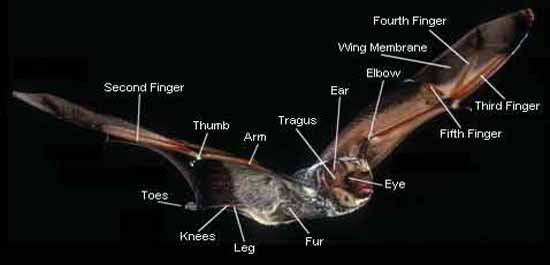
Bats come in an amazing variety of sizes and appearances. The world's smallest mammal, the bumblebee bat of Thailand, weighs less than a penny, but some flying foxes of the Old World tropics have wingspans of up to 6 feet. The big-eyed, winsome expressions of flying foxes often surprise people who would never have thought that a bat could be attractive. Some bats have long angora-like fur, ranging in color from bright red or yellow to jet black or white. One species is furless, and another even has pink wings and ears. A few are so brightly patterned that they are known as butterfly bats. Others have enormous ears, nose leafs, and intricate facial features that may seem bizarre at first, but become more fascinating than strange when their sophisticated role in navigation is explained.
The listing of bats found in Belize was provided by Dr. Bruce W. Miller, PhD. (Neotropical Bat Risk Assessments). Our original Bats of Belize page showed some species that have not actually been found in Belize. Also, it seems some of the species and sub-species names have been changed over the years. Our thanks to Dr. Miller for his kind assistance in correcting the errors on our earlier page. Hopefully, the information below is now complete and correct.
Sac-winged Bat - Emballonuridae
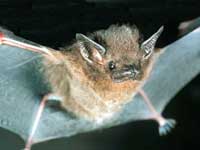
Sac-winged Bats are small, insect-feeding bats with mostly brown or gray fur and relatively large eyes. Many Sac-winged Bats roost at almost vertical substrates with the folded forearms supporting the body.
Sac-winged Bats can be found in humid rain forests, seasonal semi-deciduous forests, and savannas. Most species roost in well-lit places like entries to caves and temples, at the outside of buildings, or in hollow trees and buttress cavities of large trees.
Colonies of some the Sac-winged Bat species are easily found because these bats emit social calls audible to humans.
Emballonurid bats are aerial insectivorous bats that can be easily observed hunting for insects in a slow butterfly-like flight. Larger Sac-winged Bats, like the genus Taphozous, have a more pronounced, powerful flight. Emballonurids are among the first bats to start foraging in the evening. During periods of bad weather, some species may even start foraging in the afternoon. Occasionally, some species also glean insects from leaves.
Emballonurid bats that have been seen in Belize:
Balantiopteryx io
Centronycteris centralis
Diclidurus albus
Peropteryx kappleri
Peropteryx macrotis
Rhynchonycteris naso
Saccopteryx bilineata
Saccopteryx leptura
Bulldog Bats - Noctilionidae
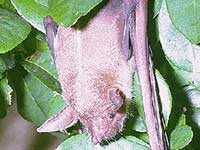
Bull-dog or mastiff bats are medium-sized bats, often brightly colored. The region around the mouth is distinctive. The lips are full and form cheek pouches, in which the bats store food as they feed while flying. The tail of bulldog bats runs through the uropatagium for about half the length of the membrane, then exits dorsally, and the terminal part of the tail is free. The feet and claws range from relatively large (Noctilio albiventris) to relatively enormous (Noctilio leporinus) in size, and the legs are proportionately longer than in most other bats. The ears are moderately large and a tragus is present. Bulldog bats have a pungent odor, described by some as "fishy.
Most Bulldog Bats feed only on insects. The only Bulldog Bat found in Belize, Noctilio leporinus, takes fish, frogs, and crustaceans as well. To capture fish, these bats use their echolocation to locate exposed fins or ripples made by fish swimming near the surface. They then drag their claws through these ripples. Their hind claws are unusually large and sharp and serve as efficient gaffs. Once out of the water, the fish is carried to a perch, where it is eaten by the bat. Noctilio leporinus may also capture insects and crustaceans on the surface of the water.
These bats usually roost near water, often in hollow trees or in deep cracks in rocks.
Free-tailed Bats – Molossidae
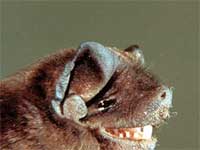
Molossids are known as free-tailed bats, because their bony tail extends to the end of a well-developed tail membrane (uropatagium) and considerably beyond. They often crawl backwards when on the ground, using their tail as a sort of "feeler." Molossids are small to moderately large bats. Their muzzles are usually short and broad, and they often have wide, fleshy lips that may have folds or creases. Many have a distinctive pad over their noses; this pad is often endowed with odd bristles with spatulate tips. Most free-tailed bats have relatively short but broad ears.
The tragus is tiny, but opposite it, an antitragus is unusually well developed. All species have long, narrow wings, apparently adapted for fast but relatively unmaneuverable flight in open places. Their wing and tail membranes are unusually tough and leathery. Molossids also have short, strong legs and broad feet. Like their nose pads, molossids' feet are well endowed with sensory bristles (also with spatulate tips). They are excellent climbers, perhaps because they launch themselves for flight from a considerable height above the ground. Because of their long, narrow wings, they must attain considerable speed before they can develop enough lift to fly. They accomplish this by falling some distance from their roost or take-off point.
Molossids generally have short, even velvety fur. Most are black or brown, and many species have distinctive reddish and brownish or blackish color phases. Their roosting habits range from solitary to living in immense colonies of millions of bats, usually in caves. In the neighborhood of these large colonies, molossids consume enormous numbers of insects.
Molossids Bats that live in Belize:
Eumops bonariensis
Eumops underwoodi
Molossus molossus
Molossus rufus
Molossus alvarezi
Nyctinomops laticaudatus
Eumops auripendulus
Eumops glaucinus
Promops centralis
Eumops hansae
Leaf-chinned Bat - Mormoopidae
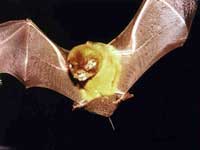
The Leaf-chinned Bat is a small to medium-sized bat. Their lips are large, and their lower lips are complexly folded and ornately decorated with plates and flaps of skin. The mouth is distinctively shaped like a funnel when open. Leaf-chinned Bats are also called "moustache bat" because of a fringe of stiff hairs on their muzzles. Their eyes are small compared to the eyes of bats of similar body size. The ears vary in size and shape but always have a tragus (which always has a secondary fold). In some species, the wings attach to the body high along the midline of the back, so that the surface of the back appears naked.
Beneath the wings, however, is a normal coating of fur. The fur of most species is brown or reddish brown, but within species some individuals vary considerably in color.
Leaf-chinned Bats are strictly insectivorous and generally live near water. They roost sociably, sometimes in very large colonies, and some species are thought to roost exclusively in caves. They can be found in a wide range of habitat types, from rainforest to arid deserts.
Mormoopidae Bats known to live in Belize:
Mormoops megalophylla
Pteronotus davyi
Pteronotus parnellii
Pteronotus personatus
Pteronotus gymnonotus
Funnel-eared Bat – Natalidae

Natalus mexicanus, the Mexican funnel-eared bat, is the only member of Natalidae that is found in Belize. They are aerial insectivores that appear to be specialists in feeding on spiders. All of these bats have funnel-shaped ears and long, slender hind legs.
Leaf-nosed Bats - Phyllostonidea
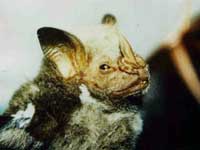
New World leaf-nosed bats are a common and diverse group that includes around 143 species, placed in 49 genera. The relationships of these genera are not fully understood.
The most conspicuous characteristic of phyllostomids is a "noseleaf", a fleshy protuberance from the nose that ranges from in size from nearly as long as the head to, in a few species, complete absence.
Many species also have bumps, warts, and other protuberances on the head near the noseleaf or on the chin. In most species, the noseleaf is a relatively simple spear-shaped structure.
Phyllostonidea Bats that have been identified in Belize:
Chrotopterus auritus
Desmodus rotundus
Diphylla ecaudata
Lonchorhina aurita
Lophostoma brasiliense
Lophostoma evotis
Lampronycteris brachyotis
Lichonycteris obscura
Micronycteris microtis
Micronycteris schmidtorum
Mimon cozumelae
Mimon crenulatum
Phyllostomus discolor
Phyllostomus hastatus
Phylloderma stenops
Tonatia saurophila
Trachops cirrhosus
Trinycteris nicefori
Vampyrum spectrum
Plain-nosed Bats – Vespertilionidae
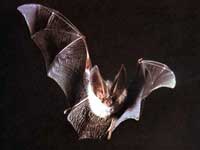
Plain-nosed Bats is the largest family of bats: it includes 35 genera and 318 species! With this many species there are exceptions to almost every generalization about this family.
Vespertilionids, or evening bats, have small eyes, ears with both a tragus (fleshy ear outgrowth) and an anterior basal lobe (except Tomopeas). Their tails are relatively long and extend to the edge of the tail membrane or beyond.
This large family includes a wide range of sizes. Some vesper bats weigh only 4 grams as adults, whereas others weigh up to 50 grams. Most of these bats are black or brown colored, but some are orangish or have other markings.
Many vespertilionids live in caves, but these bats can also be found in mine shafts, tunnels, tree roosts, rock crevices, buildings, etc. Some species contaminate human habitations with feces and noise, but this annoyance is more than offset by the bats' consumption of huge quantities of insects. Some species roost in large colonies, but others are solitary or live in small groups or pairs. Males and females tend to roost apart most of the year, and some species have maternity colonies.
Vespertilionidae bats that have been seen in Belize.
Bauerus dubiaquercus
Eptesicus furinalis
Lasiurus blossevillii
Lasiurus ega
Lasiurus intermedius
Myotis elegans
Rhogeessa aeneus
Myotis keaysi
Eptesicus fuscus
